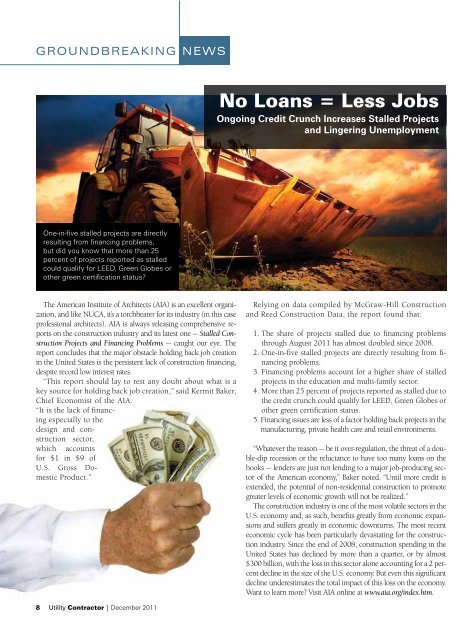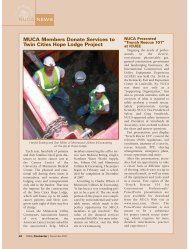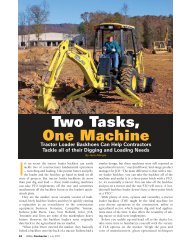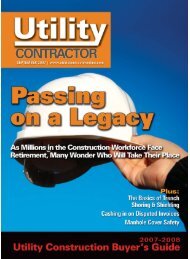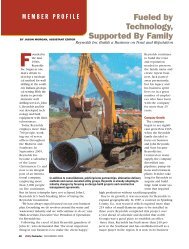View Full December PDF Issue - Utility Contractor Online
View Full December PDF Issue - Utility Contractor Online
View Full December PDF Issue - Utility Contractor Online
You also want an ePaper? Increase the reach of your titles
YUMPU automatically turns print PDFs into web optimized ePapers that Google loves.
groundbreaking news<br />
No Loans = Less Jobs<br />
Ongoing Credit Crunch Increases Stalled Projects<br />
and Lingering Unemployment<br />
One-in-five stalled projects are directly<br />
resulting from financing problems,<br />
but did you know that more than 25<br />
percent of projects reported as stalled<br />
could qualify for LEED, Green Globes or<br />
other green certification status?<br />
The American Institute of Architects (AIA) is an excellent organization,<br />
and like NUCA, it’s a torchbearer for its industry (in this case<br />
professional architects). AIA is always releasing comprehensive reports<br />
on the construction industry and its latest one — Stalled Construction<br />
Projects and Financing Problems — caught our eye. The<br />
report concludes that the major obstacle holding back job creation<br />
in the United States is the persistent lack of construction financing,<br />
despite record low interest rates.<br />
“This report should lay to rest any doubt about what is a<br />
key source for holding back job creation,” said Kermit Baker,<br />
Chief Economist of the AIA.<br />
“It is the lack of financing<br />
especially to the<br />
design and construction<br />
sector,<br />
which accounts<br />
for $1 in $9 of<br />
U.S. Gross Domestic<br />
Product.”<br />
Relying on data compiled by McGraw-Hill Construction<br />
and Reed Construction Data, the report found that:<br />
1. The share of projects stalled due to financing problems<br />
through August 2011 has almost doubled since 2008.<br />
2. One-in-five stalled projects are directly resulting from financing<br />
problems.<br />
3. Financing problems account for a higher share of stalled<br />
projects in the education and multi-family sector.<br />
4. More than 25 percent of projects reported as stalled due to<br />
the credit crunch could qualify for LEED, Green Globes or<br />
other green certification status.<br />
5. Financing issues are less of a factor holding back projects in the<br />
manufacturing, private health care and retail environments.<br />
“Whatever the reason — be it over-regulation, the threat of a double-dip<br />
recession or the reluctance to have too many loans on the<br />
books — lenders are just not lending to a major job-producing sector<br />
of the American economy,” Baker noted. “Until more credit is<br />
extended, the potential of non-residential construction to promote<br />
greater levels of economic growth will not be realized.”<br />
The construction industry is one of the most volatile sectors in the<br />
U.S. economy and, as such, benefits greatly from economic expansions<br />
and suffers greatly in economic downturns. The most recent<br />
economic cycle has been particularly devastating for the construction<br />
industry. Since the end of 2008, construction spending in the<br />
United States has declined by more than a quarter, or by almost<br />
$300 billion, with the loss in this sector alone accounting for a 2 percent<br />
decline in the size of the U.S. economy. But even this significant<br />
decline underestimates the total impact of this loss on the economy.<br />
Want to learn more? Visit AIA online at www.aia.org/index.htm.<br />
8 <strong>Utility</strong> <strong>Contractor</strong> | <strong>December</strong> 2011


